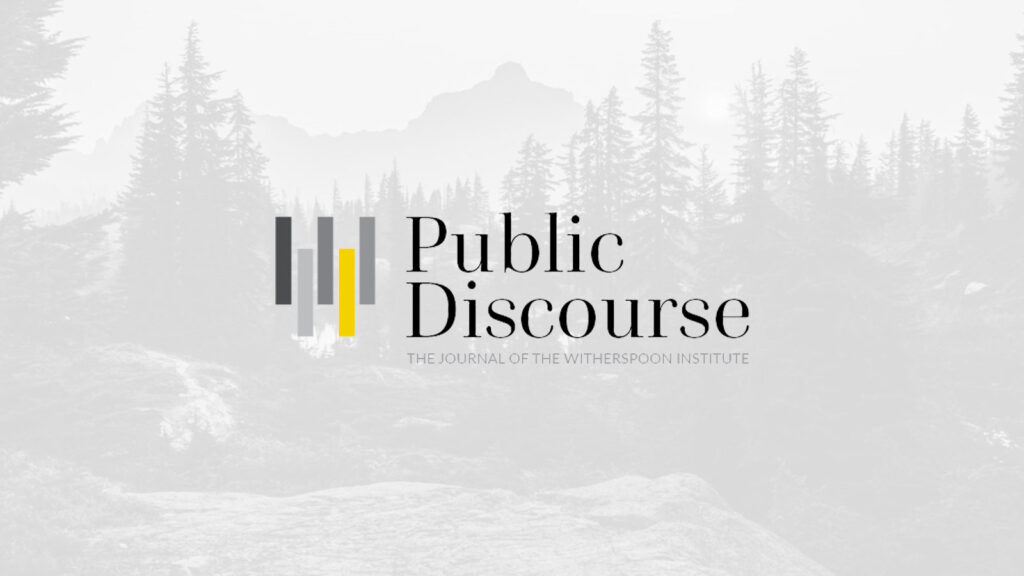Princess Leia Organa: I love you.
Han Solo: I know.
Everyone who has consumed a work of creative fiction—a feature film, TV series, or novel—can recall the moments that drew them out of themselves. I have a still-vivid memory of the first time I watched Han Solo descend into the carbon-freezing chamber in The Empire Strikes Back. It was the first time I found myself emotional, not over my own experiences or those of someone I knew, but over the plight of a fictional character.
A well-crafted work of fiction can leave us shaken or stirred. The best produce empathy, giving us the ability to understand and share another’s feelings. They put us in the shoes of an aging mob boss in 1950s New York, an American expat running a gin joint in Morocco during the early days of World War II, or a moisture farmer in a galaxy far, far away.
Start your day with Public Discourse
Sign up and get our daily essays sent straight to your inbox.From the bards of medieval Europe to gramophones playing “Peter and the Wolf,” popular media have always sought to create these moments of enchantment and empathy. But technological advances have increased their spread and impact, and fictional stories have never been so easily accessible. The power of fiction to change people’s behaviors and attitudes is amplified in today’s binge-watching, media-saturated, always-entertained society.
We spend nearly three hours a day, on average—more than half of the typical Americans’ leisure time—consuming and relating to the characters of stories on a television screen. If leisure is the basis of culture, it is impossible to change our society’s understanding of authentic human dignity and flourishing without engaging popular media. To do so effectively, we must not only have a healthy understanding of the power of fiction to form hearts and minds—we must also respect its limits.
An Impact beyond the Screen
It is natural to wonder what impact fiction can really have on lived choices. Could the decisions made by characters in a make-believe story really influence the beliefs and lifestyles of its viewers?
The evidence suggests that the answer may in fact be “Yes.” Consider Brazil, a nation whose birthrate has plummeted from 6.3 children per woman in 1963 to under 1.9 in 2012. While a number of factors have contributed to this massive cultural change, academic studies point to the impact of massively popular telenovelas, which almost exclusively feature well-off women with one or no children. By constant exposure to this idealized norm and its material benefits, researchers found that female viewers in economically aspirational households ended up with a “greater sensitivity to the opportunity costs of raising children,” an awareness that has been tied to the rapidly falling birth rate.
Closer to home, Fox’s 24 has often been credited with leading to a greater acceptance of “enhanced interrogation techniques.” Cultural critics on both the right and the left have pointed to the impact that portrayals of committed same-sex partnerships have had on making an institution that seemed laughable in the early 1990s a reality in a majority of states by the mid-2010s.
GLAAD, the organization founded as the Gay & Lesbian Alliance Against Defamation, wrote in 2012 that “it was television shows that gave [Americans] their first images of same-sex couples.” They cited ABC’s Modern Family as a recent example of a series featuring a “hilarious, loving, and relatable depiction of a committed same-sex couple,” continuing:
When shows like this show the American public just how similar the relationships of LGBT people are to their own, it becomes that much clearer that same-sex couples deserve the same protections and chance to care for one another as all Americans.
An October 2012 poll found that 27 percent of viewers who watch TV featuring gay or lesbian characters described themselves as more likely to support gay marriage after watching the program. The Hollywood Reporter, which commissioned the poll, archly noted that “social conservatives who fear the influence of gay-friendly TV are evidently right to fear it.”
The Limits of Modern Morality Tales
But fear is not a productive posture. In an attempt to fight the left’s stranglehold on Hollywood, many well-meaning individuals and institutions have sought to use the influence of popular media by creating works of fiction that dramatize traditional values. Recent years have welcomed the entry of conservative and traditionally oriented message films to the multiplex, such as Bella, Fireproof, October Baby, and others. Always earnest efforts, often marketed as family-friendly, and the product of much investment of blood, sweat, and tears, these films have sincerely sought to bring an alternative view of love, sex, and marriage to the mainstream. They feature plots that are specifically constructed to highlight, for example, the consequences of abortion or the importance of strong marriages and families.
These modern-day morality tales fully intend to be persuasive. They beg to be used as techniques for evangelism, both political and religious. Unfortunately, these message films face a steep uphill battle if they ever hope to be seen—and listened to—by viewers who aren’t already part of the choir. If traditionally minded content creators really want to engage with the general public, earnest efforts aren’t enough, and the answer isn’t just a broader advertising campaign.
As Tim Reckart, an Oscar-nominated animator and director, told the audience at the Love and Fidelity Network’s annual “Sexuality, Integrity, and the University” conference last November, a work of creative fiction requires a suspension of disbelief. If you buy a ticket to see Interstellar, you are implicitly asked to put aside your questions about the plausibility of time-bending space travel to fully immerse yourself in the tale.
When 24’s Jack Bauer tortures a suspect to prevent a terrorist attack or Frankie Dunn, played by Clint Eastwood, wrestles with the decision to euthanize his former protégée in Million Dollar Baby, these decisions are endogenous to the story. As viewers, we can agree or disagree with the character’s action, but we can’t argue with the story that created the circumstances. Even if the deck is stacked, we agreed to enter the world of the creator. We feel moments of empathy that remain with us because we’ve accompanied the characters through a journey, not argued with them about the morality of torture or euthanasia.
In contrast, Reckart pointed out, fully participating in a message-driven work requires one to submit to the premise of the story as well as the agenda motivating it. A movie that unabashedly uses its plot to drive home a message about abortion, racism, or another socially conscious topic defines itself purely as a work of rhetoric. To fully participate in viewing one of these films, one not only has to suspend disbelief, but one’s political or cultural views as well.
In this explicitly persuasive approach to storytelling, moments are created not to inspire thought or wonder, but to advance an argument. They are normative rather than descriptive. As a result, they lose their power to invite the viewer into the logic of the story. If we see plot points as exogenous inputs to drive a desired outcome, we can easily argue with how the story was constructed. When we see characters used as instruments of argumentation, we simply can’t empathize with their challenges or decisions. At best, we might leave the theater affirmed in our beliefs, but we will rarely have our views challenged or changed.
The key difference lies between fiction as description of the world as it is (or could be) and fiction as argument for how the world should be. Using the tools of fiction to try to build a persuasive story means, on a practical level, that a potential audience is probably limited to those who already accept the filmmaker’s point of view. But more crucially, blurring the lines between creative fiction and persuasive works saps the vitality from fiction, undermining its ability to open minds and hearts. The power of fiction lies in its ability to paint a picture in which we can recognize some part of ourselves. By raising the bar in terms of what it means to participate in the telling of a story, we limit fiction’s ability to create these moments of empathy.
Creating Moments, Not Arguments
It is tempting to speculate that recognizing ourselves in storytelling is nothing more than cultural narcissism, a quality in which contemporary society is certainly not lacking. But the idea that fiction’s power lies in description, not proscription, is not a new one. As Blaise Pascal wrote,
When a natural discourse paints a passion or an effect, one feels within oneself the truth of what one reads, which was there before, although one did not know it. Hence one is inclined to love him who makes us feel it, for he has not shown us his own riches, but ours.
Freed of the weight of carrying a political agenda, powerful moments can unlock a deeper sense of empathy or understanding that the force of sheer logic could never hope to compel. Through understanding others, we understand ourselves in a universally shared moment that can be used as a common touchpoint. Be it watching Han Solo being frozen by Imperial stormtroopers or seeing a telegenic gay couple on network television, these moments of empathy or insight provide us with a shared language in political or cultural discourse.
This understanding of the power of fiction to create moments of empathy—and their categorical distinctiveness from persuasive arguments—leads to different implications for artists and argument-makers.
For artists, it means using their gifts to create these opportunities to see ourselves in others without an explicit political message. In his November lecture, Reckart suggested artists take up the counter-cultural challenge of portraying families with competent fathers, the often-difficult work of building a marriage for the long term, the value of self-sacrificial love, and other virtues that frequently get short shrift. The goal should not be good art with a conservative message—the goal should be compelling art, full stop.
For writers and politicians, a healthy understanding of fiction’s power and limitations means using these shared moments of understanding we find in popular culture to illustrate broader, often more-abstract arguments about human flourishing. It also invites us to elevate the discussion over films like Zero Dark Thirty, Brokeback Mountain, and Fifty Shades of Grey to a more substantive discussion about the characters and choices in the context of the story, rather than just the next salvo in the culture wars.
In fiction, artists create worlds and moments that illuminate the way we see ourselves. Recognizing and respecting the ability and limits of this power will make us more effective communicators, storytellers, and evangelizers.













